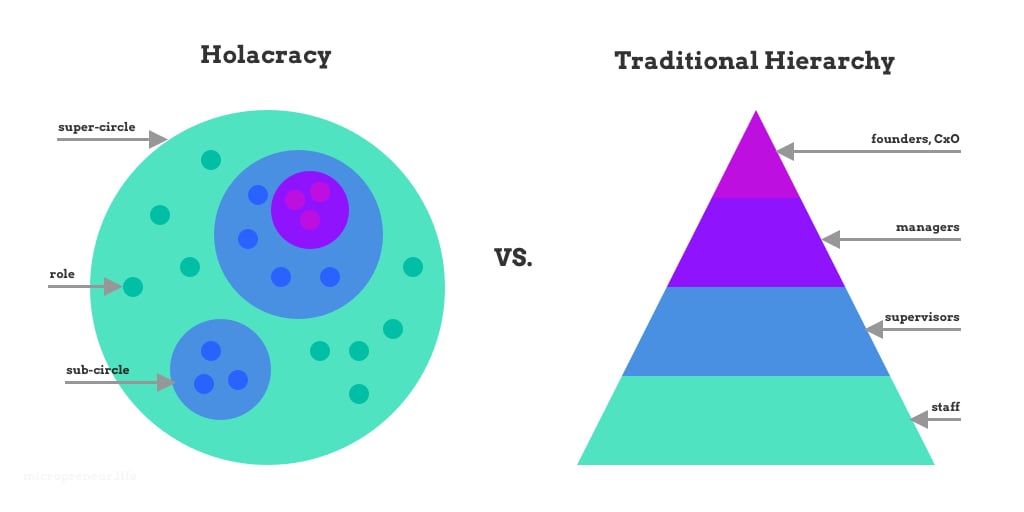I unknowingly built a Holacratic, hierarchy-less business. Here's why.

Recent events have made me think about the organizational structure of my business. When one discusses organizational schemes within organizations, there seems to be a clear distinction between startups and big corporations.
The former are supposed to be flat structures, composed of a handful of members sticking together by virtue of the bonds of friendship and excitement. The latter are highly hierarchical organizations with a long set of rules and policies, where one member of the lower levels of the pyramid can’t ask the CEO a simple question.
Curiously enough, my business does not easily fit in any of those definitions. My team, while small, cannot be considered a “startup” anymore. We are more than twenty people now, distributed in four departments.
On the other hand, we have a markedly flat structure. I stumbled upon a very interesting article about Holacracy the other day, and I realized that, without ever knowing the term, I have unknowingly created a Holacratic structure for my business.
First of all, what’s a Holacracy?
The term was coined circa 2007 by Brian Robertson, founder of Ternary Software, to describe the organizational model of his company. Derived from Holarchy (from the Arthur Koestler 1967 novel The Ghost in the Machine), this model proposes a decentralized management system that replaces authority with individual and collective responsibility. Decisions in the company are made by self-organizing teams rather than by a management hierarchy.
In other words, a Holacracy does not look like a pyramid where there’s the staff at the bottom, then there are supervisors, led by a group of managers, who are in turn under the orders of the founders and CxOs.
In an Holacracy, there are roles instead of job descriptions. A role is not equivalent to an employee, because one person can hold multiple roles at the same time.
A group of roles is structured in self-organizing (but not self-directed) circles. Each circle is assigned a clear purpose and accountabilities by its broader circle. These circles can, in turn, contain sub-circles. Every circle defines its governance processes to create and regularly update its own roles and policies. Other circles cannot interfere in their internal organization processes but can dictate their goals and make them accountable for their results.
An Holacracy is, then, not a democratic system by any means. The circles cannot do as they wish. They are directed by a purpose, and the global purpose is serving the goals of the company.
It would require me a whole set of articles to be able to offer a comprehensive perspective of what Holacracy is and how it works. If you are interested in learning more, this is a good starting point.

So is your company a Holacracy?
No, I don’t think it is. Not, at least, strictly speaking. I discovered Holacracy way after the structure of my business took shape. However, it kind of fits naturally into this organizational model.
We are an extremely flat organization. There’s no management hierarchy. Every department (or circle, depending on the nomenclature you choose) has a “chief”, but only because this is the person responsible for the accountability of that team. It is usually the most experienced person, but this individual’s role is not only managing the team, he or she actively works to advance the goals of the department.
Decisions are not taken by a manager, but by the person which is responsible for that area of expertise. They are not based on hierarchies (you are on top, I’m at the bottom or vice versa), but on knowledge and skills.
We encourage individual responsibility for each member of the team. Every customer support agent or accountant is assigned a group of customers. He or she is the one who knows how these companies work and manages them in the best way possible to serve them and the goals of the company (i.e: keeping customers happy). Some work is required to make sure knowledge is shared regularly (on short weekly meetings) to prevent somebody from hoarding all the knowledge from a specific area or becoming an irreplaceable island in the company.
While I won’t dare to affirm we are an Holacracy, I think we are pretty Holacratic.
Far beyond organizational matters
Far from organizational structures and fancy terms, it’s a matter of building a different type of company. One I would be comfortable and happy working on as an employee.
As you know, Companio, true to the Micropreneur philosophy, started as a solo project. Soon, it was clear it was a profitable business that was gaining traction and growing fast. I had to hire employees. Customers kept on growing, and I found myself leading a team of more than twenty people.
As growth was organic, we started hiring people when we needed them. They would enter a specific department and start an on-boarding process to learn everything they needed for their role with the help of their teammates. Being a remote team, we need to make an extra effort to make sure everybody feels included, helped, and supported by the rest of the team. There’s nothing that cannot be asked.
Everybody is there to support the rest of the team, and I mean everybody, including me. Not many CEOs out there will answer Slack messages from a member of their Customer Support team about a specific question they can’t find the answer to. They usually will ask their manager, and this manager will ask his or her own manager, etc.
Freedom
While we didn’t design this flat structure on purpose, I was pretty aware that it was the kind of organization I wanted to build. It may seem cliché, but one of the main values of our company is Freedom. That’s not an empty word or a gimmick. After having worked as a developer for years in highly hierarchical companies and startups (mainly North-American), spending sometimes half of my productive time filling in Jira tickets, I wanted something different. The same freedom our customers pursue.
That same quest for freedom applies to us. Most of us have been working in gray cubicles before, under the orders of a boss who knew nothing about our job, but still dared to give us orders without ever asking for our opinion. A boss who was more worried about our working hours than the results of our job.
We don’t want to build a hierarchical organization where there’s a boss telling you what to do, and a boss of that boss, and a boss of the boss of that boss. We want to work on the things we love, be responsible for our actions, and see our efforts working for the benefit of the company.
As one of my colleagues told me some days ago: we’ve grown from twenty customers to more than five hundred in a couple of years, so maybe we are not doing things so terribly bad.
And that’s a fair point. Perhaps we are building an organization that will struggle to scale past a certain point. Probably a different organization would give us a faster growth rate, but as you know, I am a strong supporter of organic growth. I want to build a business that makes sense, not hoard users at any cost to make an exit (hence the motto of this blog).
One of the major failure points I’ve always observed in large companies and governmental institutions is the dilution of responsibility. When you don’t see how your work, your actions, and your daily efforts influence the success of the company, you lose all your motivation. By making people responsible and accountable for their area of expertise, you are empowering them to have an impact on the organization as a whole.
I do believe in authority
You may get the impression that I don’t believe in authority. Nothing could be further from the truth. I do believe in authority.
I can’t really stand these modern parents who don’t like to discipline their kids when they are misbehaving. If you’ve ever seen this episode of The Simpsons, you know what I’m talking about.
I don’t believe you can reason with a three-year-old boy, or make him understand your adult, logical arguments. Sometimes, when a kid does something wrong, he needs to learn how things work the hard way. My mother has given me more than one slap during my childhood (she was also an amazingly skilled slipper-thrower. She could hit you between the eyes from a distance of twenty meters). And yet, here I am. I am not traumatized and have no problem with authority. We are talking about small corrective stimuli when needed, not abuse.
I also believe authority and discipline are important lessons to learn. Once those spoiled children who’ve been given anything get out there, to the real world, where they no longer are the center of the universe, and they cannot do as they please, that’s when the problems start.
However, in the context of a business, I believe authority needs to be displayed by means of leadership, not through fear, threats, or hierarchy enforcement. You should lead others by example. Be there for them, help them and support them, let them know you are there for them.
Marcus Aurelius, someone who could probably teach most people a thing or two about managing people, famously wrote: Be tolerant with others and strict with yourself. That quote has always had a strong influence on the way I manage my business.
Pros and cons
No business organization is perfect. A business is a living organism that changes constantly. In barely one year, we have gone from a handful of people to a team of more than twenty in Companio. Every business grows at a different pace, so they adopt different ways of coping with this growth.
In our case, this hierarchy-less approach, even if we are not following the Holacratic rules or constitution at all, has some pros and cons.
For me, the most important pro is working in a free, comfortable, and relaxed environment. We have periods of high workload and periods of stress, like everybody else. But we all work on our duties, are responsible for our outcomes, and have the freedom to organize our working schedule and tasks.
I am sure those words will make most managers out there cringe. But let me assure you that it works. We have been growing non-stop since we started, from a humble couple of customers to hundreds of them. The customer satisfaction is quite high, we have a response time of fewer than 24 hours for more than 95% of our requests and, exceptional cases aside, so far we haven’t had any major problems delivering our services (accounting, taxes, virtual office, etc) with superb quality and speed.
Another important pro is flexibility. We have managed to preserve the ultra-fast adaptability to changes we had when we were a small startup. The lack of hierarchy, bureaucracy, and paperwork means we can adopt changes very quickly, launch a new product in a couple of days or modify our internal procedures quite easily.
But as I mentioned, there’s no perfect organizational scheme. If I had to showcase a con, it would be the fact that we need an extra effort to organize and coordinate inter-departmental tasks. Being a 100% remote team has also a direct influence on this. Probably, with a hierarchy of bosses, and all the staff working in the same office building, it would be easier to keep these interdepartmental flows under control.
However, we are willing to embrace that compromise in exchange for working in a team where you don’t feel you are “working”, even when under stress or pressured by deadlines or a high workload.
Is this model future-proof? Who knows. Perhaps not, but as we’ve always done, if we need to do a profound adjustment one day, I am confident that we will do it successfully.
Conclusion
Building a flat, Holacratic organization was not something we did following a well-defined plan. However, since the team started to grow, we knew we didn’t want a hierarchical corporate structure full of bureaucracy, paperwork, and management layers. That’s the system we built at Companio.
We are proud of it, and we don’t believe you need any of those things to have a successful business. Our company is not perfect but is the company we love being part of.




Comments ()